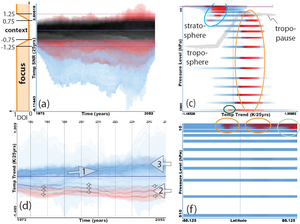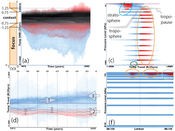Information
- Visibility: hidden
- Publication Type: Journal Paper with Conference Talk
- Workgroup(s)/Project(s):
- Date: October 2008
- Journal: IEEE Transactions on Visualization and Computer Graphics
- Volume: 14
- Number: 6
- Location: Columbus, Ohio, USA
- Lecturer: Johannes Kehrer
- Event: IEEE Visualization 2008
- Pages: 1579 – 1586
Abstract
One of the most prominent topics in climate research is the investigation, detection, and allocation of climate change. In this paper, we aim at identifying regions in the atmosphere (e.g., certain height layers) which can act as sensitive and robust indicators for climate change. We demonstrate how interactive visual data exploration of large amounts of multi-variate and time-dependent climate data enables the steered generation of promising hypotheses for subsequent statistical evaluation. The use of new visualization and interaction technology -- in the context of a coordinated multiple views framework -- allows not only to identify these promising hypotheses, but also to efficiently narrow down parameters that are required in the process of computational data analysis. Two datasets, namely an ECHAM5 climate model run and the ERA-40 reanalysis incorporating observational data, are investigated. Higher-order information such as linear trends or signal-to-noise ratio is derived and interactively explored in order to detect and explore those regions which react most sensitively to climate change. As one conclusion from this study, we identify an excellent potential for usefully generalizing our approach to other, similar application cases, as well.Additional Files and Images
Weblinks
BibTeX
@article{Kehrer-2008-hyp,
title = "Hypothesis Generation in Climate Research with Interactive
Visual Data Exploration",
author = "Johannes Kehrer and Florian Ladst\"{a}dter and Philipp Muigg
and Helmut Doleisch and Andrea K. Steiner and Helwig Hauser",
year = "2008",
abstract = "One of the most prominent topics in climate research is the
investigation, detection, and allocation of climate change.
In this paper, we aim at identifying regions in the
atmosphere (e.g., certain height layers) which can act as
sensitive and robust indicators for climate change. We
demonstrate how interactive visual data exploration of large
amounts of multi-variate and time-dependent climate data
enables the steered generation of promising hypotheses for
subsequent statistical evaluation. The use of new
visualization and interaction technology -- in the context
of a coordinated multiple views framework -- allows not only
to identify these promising hypotheses, but also to
efficiently narrow down parameters that are required in the
process of computational data analysis. Two datasets, namely
an ECHAM5 climate model run and the ERA-40 reanalysis
incorporating observational data, are investigated.
Higher-order information such as linear trends or
signal-to-noise ratio is derived and interactively explored
in order to detect and explore those regions which react
most sensitively to climate change. As one conclusion from
this study, we identify an excellent potential for usefully
generalizing our approach to other, similar application
cases, as well.",
month = oct,
journal = "IEEE Transactions on Visualization and Computer Graphics",
volume = "14",
number = "6",
pages = "1579--1586",
URL = "https://www.cg.tuwien.ac.at/research/publications/2008/Kehrer-2008-hyp/",
}


 Draft
Draft Slides
Slides

